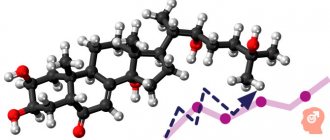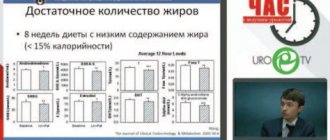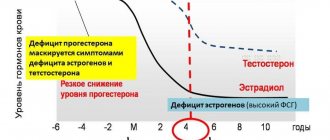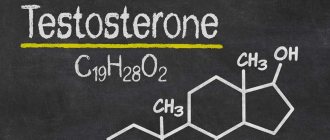Testosterone total
How to control men's health throughout life?
Testosterone is the most active male sex hormone. It is responsible for a number of important processes in the male body, including the formation of the body according to the male type, regulation of male fertility, and puberty.
Do not forget that the growth of muscle mass and libido level depend on the level of testosterone in the body. There are two states in which this hormone can be in the blood - free and bound to proteins. Free testosterone makes up only 2% of the total, all other cells are bound to proteins.
If you have been prescribed a test for total testosterone, the test will assess the amount of the hormone as a whole. If you need to determine the level of free testosterone, there is a specific study for this. It is known that the body's production of testosterone increases significantly after exercise. Therefore, it is important to exclude any training and exercise before analysis.
In men, testosterone is produced by Leydig cells and is controlled by luteinizing hormone. The overwhelming amount of testosterone is bound to globulin, which is responsible for the binding of sex hormones. Also, this hormone is able to form a weak bond with albumin and remain in a free state for some time. If a man has a pathological decrease in total testosterone, this may indicate diseases such as:
- Hypogonadism;
- Hyperprolactinemia;
- Kidney failure;
- Cirrhosis of the liver;
- Klinefelter's syndrome.
By examining biological material for the level of total testosterone, its increase can also be determined. If the result showed excessive levels of the hormone in the blood, this may indicate:
- Pathologies of the hypothalamic-pituitary-testicular system;
- Tumors of the adrenal glands or testicles;
- Congenital adrenal hyperplasia.
The ovaries, adrenal glands and peripheral fat cells are responsible for the production of total testosterone in women. According to medical data, the level of testosterone in a woman’s body is approximately 10 times less than in men. In women, the bulk of testosterone is bound to albumin and only a small part circulates throughout the body in a free state. If a testosterone test in a woman shows a result exceeding the norm, this may indicate:
- Polycystic ovary syndrome;
- Stromal hyperthecosis;
- Tumors of the ovaries or adrenal glands;
- Congenital adrenal hyperplasia, as well as a number of other serious pathologies that require immediate treatment.
If you need a blood test for total testosterone, you can do so at any of our medical centers or visit one of our partner laboratories.
Deciphering testosterone analysis
| Floor | Age | Testosterone level, nmol/l |
| Female | 4 days - 9 years | < 2,15 |
| 9 – 13 years | < 0,98 | |
| 13 – 15 years | 0,36 – 1,54 | |
| 15 - 18 years old | 0,49 – 1,70 | |
| 18 – 50 years | 0.52-1.72 Pregnancy: up to 3-4 times higher than non-pregnant values. | |
| Over 50 years old | 0,46 — 1,18 | |
| Male | 4 days - 6 months. | 0,30 — 10,36 |
| 6 months - 9 years | < 1,24 | |
| 9 – 11 years | < 0,81 | |
| 11 – 14 years | < 15,41 | |
| 14 - 16 years old | 1,25 — 21,92 | |
| 16 - 18 years old | 5,13 — 27,53 | |
| 18 – 50 years | 8.9 - 42.0 Lower diagnostic threshold recommended by ISSAM: 12 nmol/l | |
| Over 50 years old | 8,6 — 23,4 |
Indications for analysis
The appointment, interpretation of the analysis and diagnosis are carried out by the following specialists: endocrinologist, gynecologist, urologist, andrologist, reproductive specialist, therapist, pediatrician, family doctor.
For representatives of both sexes, a testosterone test is prescribed in the following cases:
- infertility;
- pathological baldness (alopecia);
- acne in adulthood;
- oily seborrhea, dandruff;
- aplastic anemia (impaired production of blood cells by the bone marrow);
- adrenal neoplasms;
- control of the intake of certain medications: glucocorticoids, steroids, androgens, etc.
Additionally for men:
- Impaired potency and erectile dysfunction;
- decreased sex drive;
- pathological age-related changes;
- hypogonadism (testicular dysfunction) primary and secondary;
- osteoporosis (a chronic skeletal disease associated with increased fragility and fragility of bones).
Additionally for women:
- menstrual irregularities: anovulation (lack of ovulation);
- amenorrhea (absence of menstruation of primary or secondary nature);
- oligomenorrhea (extension of the menstrual cycle to 35 days or more);
Tests for coronavirus
- Test for coronavirus
- Coronavirus test for organizations
- Testing for coronavirus at home
- Testing for coronavirus at home in 12 hours!
- Testing for coronavirus in Lyubertsy in 12 hours!
- Testing for coronavirus in Nekrasovka in 12 hours!
- Testing for coronavirus in Korolev in 12 hours!
- Test for coronavirus on the Sokol metro station
- Coronavirus test at Kolomenskaya metro station
- Coronavirus test at Voykovskaya metro station
- Test for coronavirus in Nekrasovka
- Coronavirus test in Korolev
- Test for coronavirus in Lyubertsy
- Test for coronavirus in Mytishchi
- Test for coronavirus at home Mytishchi
- Test for coronavirus at home Korolev
- Test for coronavirus at home Lyubertsy
- Test for coronavirus at home Nekrasovka
Any tests can be taken at clinics in the East Clinic network.
Reference values
| Patient age | Women, pg/ml | Men, pg/ml |
| 6 – 12 years | < 1,46 | < 4,6 |
| 12 – 19 years old | < 2,24 | 0,18 – 23,08 |
| 19 – 55 years old | < 2,85 | 1,0 – 28,28 |
| Over 55 years old | < 1,56 | 0,7 – 21,45 |
Factors influencing the result
- Presence of chronic diseases;
- Dysfunction of the endocrine system;
- Violation of the rules for preparing for analysis;
- Violation of the venipuncture algorithm, as well as the requirements for transportation and storage of biomaterial;
- Taking medications: nilutamide;
- rifampin;
- danazol;
- magnesium sulfate;
- ketoconazole;
- dexamethasone;
- methylprednisolone;
- prednisole;
- thioridazine;
- tetracycline, etc.
Reasons for false results
Possible reasons for a false testosterone test result:
- Taking medications that contain testosterone can change the test result.
- The level of biologically active substance increases significantly with increased physical activity. Minor physical activity a few hours before blood sampling will lead to an increase in the amount of testosterone in the blood.
- An increase in body temperature can distort the sample value.
- Long-term fasting or a diet restricting proteins and fats changes the indicators.
- The final value is greatly influenced by the use of drugs that regulate the intensity of hormone production.
- The result is affected by the use of barbiturates, cardiac glycosides, neuroleptics, and diuretics. All of them, except barbiturates, reduce the level of the hormone in the body.
In women, the level of male sex hormone changes with the onset of pregnancy.
What causes increased testosterone?
• Adrenogenital syndrome provokes high testosterone in women;
• New growth of the testes increases testosterone in men;
• Disease or Itsenko-Cushing syndrome;
• A neoplasm in a woman’s ovaries, leading to the development of “masculinity” (deepening of the voice, a figure similar to a man’s, etc.);
• Decreased sex steroid binding globulin, or SHBG, in the blood;
• Excess and high intensity physical activity;
• The use of certain medications, such as levonorgestrel, mifepristone and various oral contraceptives, as well as tamoxifen, finasterine, danazol, phenytoin, etc.
Causes and consequences of testosterone level disorders
Free testosterone may decrease with:
• Hypogonadism;
• Alzheimer's disease;
• Cytochrome P450 deficiency;
• Erectile dysfunction;
• Using antidepressants;
Less commonly, low free testosterone occurs in older men, as well as after long-term treatment with steroid hormones.
Elevated testosterone is detected when:
• Hirsutism. This is excess hair growth in women with uncharacteristic localization of this growth - on the face, chin;
• Tumors of the adrenal glands;
• Polycystic ovary syndrome;
• Resistance of cell receptors to androgens.
Follicle-stimulating hormone and its main functions in the female body
Follicle-stimulating hormone (FSH) is a hormone that is involved in regulating the maturation of follicles in a woman’s ovaries. FSH is produced by the pituitary gland.
Another name for the above hormone is follitropin.
The main functions of FSH in the female body:
- the main function, as mentioned above, is to ensure the growth of follicles in the ovaries of the female body;
- responsible for the production of estrogen;
- participates in the process of converting testosterone into estrogen.
Bad habits (alcohol abuse, smoking), stress, depression, taking a certain group of medications, kidney and genital diseases, X-ray exposure - all this can negatively affect the level of follitropin in a person’s blood.
Recommendations for testing the level of FSH in the blood:
- It is advisable to eliminate physical training for 2-3 days;
- the day before the test, avoid sexual intercourse;
- one hour before the test, do not smoke and try to calm down;
- Testing on an empty stomach is required.
It is necessary to carefully follow these recommendations so that the analysis is more reliable, which is very important, because deviations in the level of follicle-stimulating hormone may indicate the presence of a number of specific problems that interfere with pregnancy.
Decreased testosterone
- Hypogonadism;
- Violation of the production of gonadotropic hormones by the pituitary gland;
- Hyperprolactinemia (increased serum prolactin hormone);
- Impaired potency, chronic prostatitis in men;
- Obesity of all types (in men);
- Adrenal insufficiency.
On a note:
a decrease in testosterone production can occur due to changes in diet (low-carbohydrate or low-lipid diets, fasting, vegetarianism, fasting, etc.). Also, the concentration of the hormone decreases in case of prolonged alcohol intake.
How is the analysis carried out?
Blood is drawn from a vein. There are many ways to determine the level of free testosterone in the blood. In practice, radioimmunoassay is most often used, but it is considered not very accurate. Its use is determined by the low cost of the entire process.
Currently, the most accurate way to calculate testosterone levels in the blood is the double dialysis and ultracentrifugation method. But due to its high cost and labor intensity, it is used extremely rarely.
Preparation for the procedure
You need to prepare for a testosterone test.
- The material is collected in the morning, on an empty stomach. The last meal should take place no earlier than eight hours before the visit to the treatment room.
- Alcohol should not be consumed during the seven days preceding the test.
- Two weeks before donating blood, you must stop taking medications. If this cannot be done, the dose and name of the drug that was taken are indicated on the referral.
- A few days before the examination, doctors recommend limiting physical activity and avoiding sexual intercourse.
- On the eve of handing over the material, you should not consume large amounts of salt, overeat meat, sweets and baked goods.
- Smoking is prohibited for eight hours prior to the test.
Failure to follow the preparation rules greatly increases the likelihood of a false result.
What is the research used for?
A test for free testosterone is prescribed to men and women by their attending physician in order to identify certain health problems if signs are already appearing. The results provide an understanding of the processes that occur in the body and help prescribe the correct and most necessary treatment. The hormone is also given to diagnose certain pathologies, when nothing can be said externally.
Free testosterone is given according to a specialist’s indications for the purpose of:
- identifying the causes of delayed or early puberty in adolescents;
- in case of infertility or impotence of a man;
- if you suspect a tumor in the gonads;
- identifying the causes of virilization in women;
- to monitor the process of treating a tumor in the prostate;
- for acne on the face;
- to diagnose disorders in the hypothalamic-pituitary gland and evaluate the endocrine system as a whole;
- to determine the sex of a fetus with ambiguous sexual characteristics;
- if you are overweight;
- for problems with the thyroid gland;
- with sexual weakness or manifest impotence;
- in the case of undergoing therapy with antidepressants and identifying changes occurring in the body against this background.
Norms and decoding
The amount of testosterone in the blood changes with age. From eighteen to fifty years, a level from 5.76 to 30.43 nmol/l is considered normal. In older men, the levels are lower, from 5.41 to 19.54 nmol/l.
The normal level of the hormone in the blood of women is:
- from twenty to forty years - 0.12-3.1 nmol/l;
- from forty to sixty years - from 0.12-2.6 nmol/l;
- over 60 - from 0.12 to 1.7 nmol/l.
Excess testosterone levels can be observed:
- During early sexual development.
- When a tumor grows in the area of the adrenal glands.
- When extragonadal germ cell tumors are detected.
- With a low level of globulins, which should bind free testosterone.
- With adrenal hyperplasia.
- In the presence of Itsenko-Cushing's disease.
Possible causes of decreased testosterone:
- If the patient has Down Syndrome.
- With a high degree of obesity.
- With the development of chronic prostatitis.
- For liver and kidney failure.
- With Steinert's disease.
- In the presence of cryptorchidism and uremia.
- For Klinefelter and Kallmann syndromes.
- With primary and secondary hypogonadism.
In women, increased testosterone levels are accompanied by:
- Expansion of areas with hair, more characteristic of secondary male characteristics.
- The hair itself becomes thicker and darker. The hair on your head gets greasy and dirty faster.
- Changes in skin structure. It becomes drier, which is why it often flakes off. With a weak impact on it, cracks form.
- Changes affect the voice, it becomes rougher.
Muscle mass is gained quickly. In some cases, rapid weight gain occurs. The figure takes on a male outline. There is a change in psychotype. A woman becomes more active and at the same time her level of aggression increases, which was not observed before the illness.
A decrease in hormone levels also negatively affects a woman’s health.
- At the same time, massive hair loss begins not only on the head, but throughout the body. The volume of muscle tissue decreases.
- Fatigue increases.
- The amount of subcutaneous fat increases.
- Dryness of the skin increases.
- Sexual desire almost completely disappears.
- There are frequent mood swings when periods of activity are replaced by depression and depression.
- If there is a lack of testosterone, sexual intercourse may be accompanied by unpleasant sensations that appear due to a lack of secretion, which is produced under the influence of the hormone.
Hormonal imbalance is a serious problem that requires competent treatment under the supervision of an endocrinologist.









